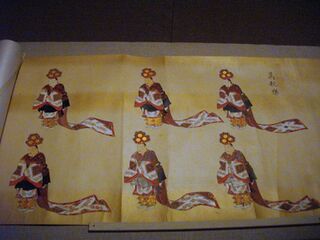Difference between revisions of "Bugaku"
| Line 7: | Line 7: | ||
The Chinese-style dances are typically accompanied by three types of flutes (''[[hichiriki]]'', ''[[ryuteki|ryûteki]]'', and ''[[sho|shô]]'') and percussion instruments such as the ''[[kakko]]'', ''[[shoko|shôko]]'', and ''[[taiko]]'', without string instruments. The Korean-style dances, the ''shô'' and ''ryûteki'' are replaced by the Korean-style flute (''[[komabue]]''), and the ''san-no-tsuzumi'' instead of ''kakko''. | The Chinese-style dances are typically accompanied by three types of flutes (''[[hichiriki]]'', ''[[ryuteki|ryûteki]]'', and ''[[sho|shô]]'') and percussion instruments such as the ''[[kakko]]'', ''[[shoko|shôko]]'', and ''[[taiko]]'', without string instruments. The Korean-style dances, the ''shô'' and ''ryûteki'' are replaced by the Korean-style flute (''[[komabue]]''), and the ''san-no-tsuzumi'' instead of ''kakko''. | ||
| + | |||
| + | ==Bugaku Dances== | ||
| + | *''Konju'' 胡飲酒 (aka ''Suigoraku'' 酸胡楽, ''Eninraku'' 宴飲楽, ''Inshuraku'' 飲酒楽) - a dance based on or inspired by foreigners dancing drunkenly. This dance was performed by members of the [[O family|Ô family]] (多家) since ancient times, but around [[1100]], [[O no Suketada|Ô no Suketada]] was killed by [[Yamamura Masatsura]], and the performance of this dance was suspended for a time. The mask for this dance is a dark red, with large eyes and long black hair.<ref>Masks and gallery labels on display at Mitsukoshi department store, Nihonbashi, Aug 2014.[https://www.flickr.com/photos/toranosuke/15786433330/]</ref> | ||
{{stub}} | {{stub}} | ||
| Line 13: | Line 16: | ||
*Gallery labels, [[Tokyo Imperial Palace]].[https://www.flickr.com/photos/toranosuke/18200814551/sizes/k/] | *Gallery labels, [[Tokyo Imperial Palace]].[https://www.flickr.com/photos/toranosuke/18200814551/sizes/k/] | ||
*Gallery label, "Bugaku Scroll," Metropolitan Museum of Art, 57.52.1.[https://www.flickr.com/photos/toranosuke/3298209948/sizes/l] | *Gallery label, "Bugaku Scroll," Metropolitan Museum of Art, 57.52.1.[https://www.flickr.com/photos/toranosuke/3298209948/sizes/l] | ||
| + | <references/> | ||
[[Category:Nara Period]] | [[Category:Nara Period]] | ||
[[Category:Poetry and Theater]] | [[Category:Poetry and Theater]] | ||
Revision as of 00:58, 17 November 2021
- Japanese: 舞楽 (bugaku)
Bugaku is a classical Japanese form of Imperial court dance, closely associated with gagaku court music. It is derived from a combination of Shinto dance and Chinese, Korean, and Southeast Asian influences, and developed into its mature form largely in the 8th-9th centuries.
Like gagaku court music, which is divided into Chinese- and Korean-derived forms (Tôgaku and Komagaku), bugaku is divided into three categories: kuniburi-no-mai (native Japanese dances), Sa-no-mai (dances of the left, derived from those of the Tang Dynasty first introduced in 698), and U-no-mai (dances of the right, derived from those of Korea). The Chinese-style dances typically use red costumes, while the Korean-style ones use green costumes. Performers included both court nobles and hereditary guilds of court entertainers, and bugaku continued through to the modern era.
The Chinese-style dances are typically accompanied by three types of flutes (hichiriki, ryûteki, and shô) and percussion instruments such as the kakko, shôko, and taiko, without string instruments. The Korean-style dances, the shô and ryûteki are replaced by the Korean-style flute (komabue), and the san-no-tsuzumi instead of kakko.
Bugaku Dances
- Konju 胡飲酒 (aka Suigoraku 酸胡楽, Eninraku 宴飲楽, Inshuraku 飲酒楽) - a dance based on or inspired by foreigners dancing drunkenly. This dance was performed by members of the Ô family (多家) since ancient times, but around 1100, Ô no Suketada was killed by Yamamura Masatsura, and the performance of this dance was suspended for a time. The mask for this dance is a dark red, with large eyes and long black hair.[1]
References
- Gallery labels, Tokyo Imperial Palace.[2]
- Gallery label, "Bugaku Scroll," Metropolitan Museum of Art, 57.52.1.[3]
